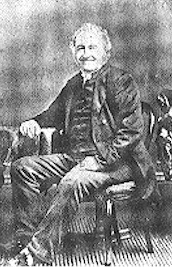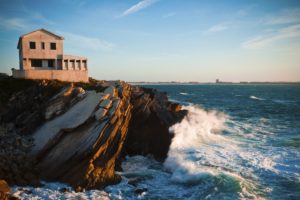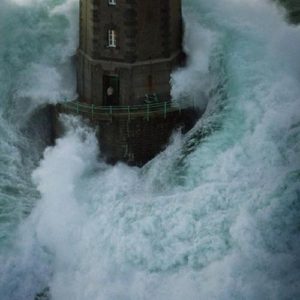My Hope Is Built on Nothing Less
Main Texts: Acts 4:11–12; Matthew 16:18; Matthew 7:24-25; 24:31
(Lutheran Service Book 575, 576)
My hope is built on nothing less
Than Jesus’ blood and righteousness;
No merit of my own I claim
But wholly lean on Jesus’ name.
Refrain (after each stanza):
On Christ, the solid rock, I stand;
All other ground is sinking sand.
When darkness veils His lovely face,
I rest on His unchanging grace;
In ev’ry high and stormy gale
My anchor holds within the veil.
His oath, His covenant and blood
Support me in the raging flood;
When ev’ry earthly prop gives way,
He then is all my hope and stay.
When He shall come with trumpet sound,
Oh, may I then in Him be found,
Clothed in His righteousness alone,
Redeemed to stand before His throne!
 “My Hope Is Built on Nothing Less,” by Edward Mote (1797-1874), was written about 1834. He once shared how he came to write the words.
“My Hope Is Built on Nothing Less,” by Edward Mote (1797-1874), was written about 1834. He once shared how he came to write the words.
One morning it came into my mind as I went to labour, to write a hymn on the “Gracious Experience of a Christian.” As I went up Holborn I had the chorus … In the day I had four verses complete, and wrote them off.
Mote then called on a parishioner whose wife was ill. The husband, accustomed to singing a hymn in his private devotions, was unable to find his hymnbook, so Mote offered the completed four stanzas. The dying woman was so taken with the hymn that Mote, after leaving a copy with her, later finished off two more stanzas and had a thousand copies printed in leaflet form.
Mote had “gone astray” from the faith of his childhood but, through the preaching of John Hyatt, was returned to Christ. Mote became a Baptist minister when he was 55 years old, and in that vocation remained until his death. Before that he was a cabinetmaker. Based on the dates given, it seems Mote was still a cabinetmaker when he visited the dying woman and wrote “My Hope Is Built on Nothing Less.”
The hymn actually appears twice in our hymnal (hymns 575 and 576). Both tunes are well known.
In Acts 3, Peter and John are going to the temple at the hour of prayer. There they encounter a lame beggar whom Jesus heals when Peter says, “In the name of Jesus Christ of Nazareth, rise up and walk!” After the man was healed he made quite a scene, leaping and praising God, which drew a crowd. Peter then speaks to the crowd, sharing eternal life by grace through faith in Jesus. Chapter four begins with Peter and John being arrested. They were brought before “their rulers and elders and scribes … with Annas the high priest and Caiaphas and John and Alexander, and all who were of the high-priestly family.” These were all the power-players of the Jewish people. These were the men responsible for the crucifixion of Jesus.
When questioned about how the lame may was healed, Peter did not duck the question. Ever a blunt man, Peter said, “… let it be known to all of you and to all the people of Israel that by the name of Jesus Christ of Nazareth, whom you crucified, whom God raised from the dead—by him this man is standing before you well.” Peter continues to tell the Sanhedrin, “This Jesus is the stone that was rejected by you, the builders, which has become the cornerstone. And there is salvation in no one else, for there is no other name under heaven given among men by which we must be saved” (Acts 4:11-12). In other words, when the leaders rejected Jesus, they did more than kill a troubling preacher, they actually rejected the cornerstone of God’s Church on earth and their salvation. They had rejected the “solid rock.”
When Peter said that salvation is found in no one else except Jesus, his comment was just as scandalous then as it is today. For the Jewish leaders, Peter was teaching that Jesus is God (Exodus 15:2; 2 Samuel 22:47; Psalm 18:2; etc.). For non-Jews, Peter’s statement of salvation exclusively through Jesus invalidated all other religions. These religions and philosophies are “sinking sand.”
 This scandalous theme of exclusivity runs through the Bible. Even Jesus teaches it. In Matthew 16 Jesus is traveling with his disciples and warning them about the teachings of the Pharisees and Sadducees. These two groups agreed on little, but that doesn’t mean one group was right and the other group was wrong. Error is multifaceted, truth is singular. In demonstrating this, Jesus asked his disciples for a survey of popular opinion concerning his identity. Not a single option was correct. Then Jesus asked who they thought he was. Peter responds with “You are the Christ, the Son of the living God.” Peter was right! So Jesus responds, “I tell you, you are Peter, and on this rock I will build my church, and the gates of hell shall not prevail against it” (Matthew 16:18).
This scandalous theme of exclusivity runs through the Bible. Even Jesus teaches it. In Matthew 16 Jesus is traveling with his disciples and warning them about the teachings of the Pharisees and Sadducees. These two groups agreed on little, but that doesn’t mean one group was right and the other group was wrong. Error is multifaceted, truth is singular. In demonstrating this, Jesus asked his disciples for a survey of popular opinion concerning his identity. Not a single option was correct. Then Jesus asked who they thought he was. Peter responds with “You are the Christ, the Son of the living God.” Peter was right! So Jesus responds, “I tell you, you are Peter, and on this rock I will build my church, and the gates of hell shall not prevail against it” (Matthew 16:18).
To understand Jesus words we need a bit of background. First, Peter’s real name was Ceaphas. Ceaphas is Aramaic. Peter is Greek, and means “rock.” So Jesus is making a play on words. The word translated “Peter” is a diminutive of “rock.” In other words, it means “little rock” or “pebble” or something like that; A chip off the old block. The “rock” is faith in Jesus as “the Son of the living God” and Peter is to be known as a chip off of this great rock. It is on this great rock, the rock of Jesus, that the Church is built.
Jesus goes on to tell the disciples that the Church, built on the rock of faith in Jesus, will prevail against the gates of hell. There are several thoughts behind this metaphor. Armies on the attack do not have gates. Cities have gates. The Church is advancing, winning souls in every generation and in every land. Jesus accomplishes this through the Means of Grace (Word and Sacraments). Another thought is that the Church prevails. No matter what hell does, the Church, that is, true faith in Jesus, remains until the Second Coming of Jesus.
 Yes, there will be times when “darkness veils His lovely face,” when we face “high and stormy gales,” when we “face raging floods” and every “earthly prop gives way,” but the Church remains. When the final trumpet is blasted, those who are clothed in his righteousness, and his alone, stand victorious before the throne of God.
Yes, there will be times when “darkness veils His lovely face,” when we face “high and stormy gales,” when we “face raging floods” and every “earthly prop gives way,” but the Church remains. When the final trumpet is blasted, those who are clothed in his righteousness, and his alone, stand victorious before the throne of God.
At the end of his famous “Sermon on the Mount” (Matthew 5-7) Jesus tells us more about building on “the rock.” “Everyone then who hears these words of mine and does them will be like a wise man who built his house on the rock. And the rain fell, and the floods came, and the winds blew and beat on that house, but it did not fall, because it had been founded on the rock” (Matthew 7:24-25). This is where Mote draws many of his images used in the hymn. But the Church, built on the rock of the Gospel, which Peter and the other apostles proclaim, remains standing. When we cling to the Gospel, we are like the wise man who built his house on the solid rock, it does not fall in the storms of life. Building one’s hope for salvation on anything other than the Gospel is disastrous and like building on shifting sand.
Jesus also said, “And everyone who hears these words of mine and does not do them will be like a foolish man who built his house on the sand. And the rain fell, and the floods came, and the winds blew and beat against that house, and it fell, and great was the fall of it” (Matthew 7:26-27). The false hopes of false faiths simply do not stand up to the storms of life, especially the final storm, the Last Day, which Mote is speaking of especially in our last verse. Jesus, in speaking about this Last Day, said “And he [the Son of Man, that is, Jesus] will send out his angels with a loud trumpet call, and they will gather his elect from the four winds, from one end of heaven to the other (Matthew 24:31). Those who have not received faith in Jesus will “mourn” (verse 30), for they will be seeing their time of grace coming to an end. The “elect,” that is, those who have received the faith Peter confessed and therefore been built on the Solid Rock, will be “clothed in His righteousness alone, Redeemed to stand before His throne!”
